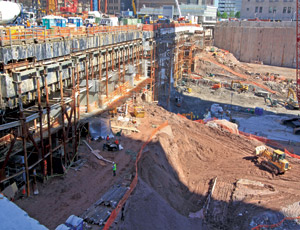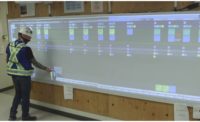Call it Underground Zero. In the middle of the World Trade Center site in Manhattan, workers are performing an intricate balancing act with steel and concrete, excavating beneath an active subway line while a number of other projects progress around them. The top-down permanent underpinning of the subway tunnel will create much-needed space for a new nearby iconic transit station as well as other facilities.
No. 1 subway line runs through a structural box on grade that traverses north-south about 1,000 ft across Ground Zero, just feet from a Port Authority of New York and New Jersey-run trans-Hudson subway line. Crews are excavating below the box in approximately 14-ft increments, working through a forest of rebar and about 500 minipiles, a vestige of a former reconstruction effort.
Downtown Design Partnership (DDP), a joint venture of the New York City offices of STV Inc. and AECOM, redesigned the underpinning scheme to ensure that the work will be done in time for the 10th anniversary of 9/11, says Michael Garz, STV design manager. To shut down the line and completely rebuild it “may have been the simplest approach from a construction standpoint, but it was the least desirable politically,” he says.
After the first stage of excavation about 14 ft below the subway box, crews poured a concrete slab and wall sections, says Eric Reid, senior project manager with the port authority’s construction manager, a local joint venture of Tishman Construction Corp. and Turner Construction Co. Temporary bracing is installed, and workers continue to excavate beneath the slab. Another 14 ft or so down, they repeat the process. Excavation along the 1,000-ft length also has to be done in alternating 50-ft sections to maintain stability, says Reid.
“We pour the first area, skip the second, pour the third,” adds Jeff Brown, project manager for Tutor Perini Civil, Peekskill, N.Y., which holds the two-year, $213-million contract. It could earn up to $10 million in bonuses for meeting six milestones, or face liquidated damages of $6,000 a day after the estimated substantial completion date in June 2011, according to the port authority.
On the third, final subterranean increment, crews are excavating granite and quartz. “They’re chopping it up with every type of equipment—hoe rams, modified mini-excavators,” says Brown. Nearly 120,000 cu yd of material are being removed by a crane, lifted 90 ft out of the pit.
At a depth of about 50 ft, crews will pour the bottom slab and wall sections. Next, they will pour a final 3-ft-thick slab directly beneath the subway box. “Then we release the subway box down onto that slab,” says Brown. Crews will remove the temporary piles, and the subway will then rest on the concrete box.
Tutor Perini is surrounded by other contractors. At the point where the new transit station, designed by Santiago Calatrava with DDP, will pass below the subway, DCM Erectors Inc. will install two 300-ft-long steel trusses to support the subway before crews remove the temporary steel bracing, says Reid. A joint venture of Skanska USA and Granite Construction is building the PATH station under its $543-million contract.
The 60-ft-wide top of the subway box is serving as an access road for eight other contracts, notes Brown. The loads and movements must be carefully monitored. “Everyone’s playing well in the sandbox,” says Reid.























Post a comment to this article
Report Abusive Comment